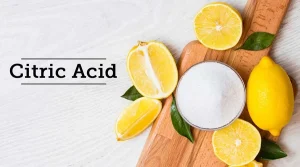Introduction
Citric acid, a naturally occurring organic acid, is widely used as a food additive due to its acidic and preservative properties. Found in citrus fruits such as lemons and oranges, it plays a significant role in the food and beverage industry, enhancing flavor, maintaining pH balance, and preserving freshness. Understanding the properties, sources, applications, safety, and alternatives of citric acid is crucial for its effective and safe utilization in various food products.
Properties of Citric Acid

Citric acid, with the chemical formula C₆H₈O₇, is a weak organic acid. It is highly soluble in water, and its acidity is characterized by a pKa value of 3.13. The acid exists in crystalline form and has a sour taste, making it a popular ingredient for adding tartness to foods and beverages. Its ability to chelate metals enhances its functionality as a preservative and antioxidant.
Sources of Citric Acid
Citric acid naturally occurs in citrus fruits, including lemons, limes, and oranges. It is extracted from these fruits for various applications. Industrially, citric acid is produced through fermentation processes involving Aspergillus niger, a mold that ferments sugars to produce the acid. This method is favored for large-scale production because of its efficiency and cost-effectiveness.
Roles of Citric Acid in Food
Citric acid serves multiple functions in the food industry:
- Acidity Regulator: It adjusts the pH levels of food and beverages, enhancing flavor and stability.
- Antioxidant: Citric acid prevents oxidation, thereby extending the shelf life of food products.
- Preservative: Its antimicrobial properties prevent the growth of bacteria and mold.
- Flavor Enhancer: Citric acid intensifies flavors, making food products more appealing.
Safety of Citric Acid
The safety of citric acid as a food additive is well-established. Regulatory organizations like the World Health Organization (WHO) and the U.S. Food and Drug Administration (FDA) deem it generally safe for consumption. The acceptable daily intake (ADI) for citric acid is set based on extensive toxicological studies. While generally safe, excessive consumption may cause gastrointestinal discomfort in sensitive individuals.
Applications of Citric Acid

Citric acid is used extensively in various food products:
- Beverage Industry: It is a key ingredient in carbonated drinks, providing tartness and acting as a preservative.
- Confectionery and Baking: Citric acid improves the flavor and texture of candies and baked goods.
- Dairy and Canned Foods: It extends the shelf life of dairy products and canned foods by preventing spoilage.
Alternatives to Citric Acid
Other acidulants can replace citric acid in certain applications:
- Tartaric Acid: Commonly used in wine production, it offers similar acidity regulation.
- Lactic Acid: Found in fermented products, it serves as both a preservative and flavoring agent.
Each alternative has its pros and cons, making the selection dependent on the specific needs of the food product.
Conclusion
Citric acid is indispensable in the food industry due to its multifaceted roles as an acidulant, preservative, antioxidant, and flavor enhancer. Ensuring its safe and appropriate use is vital for maintaining food quality and consumer health. Future research and innovations may expand its applications, further solidifying its position as a crucial food additive.
